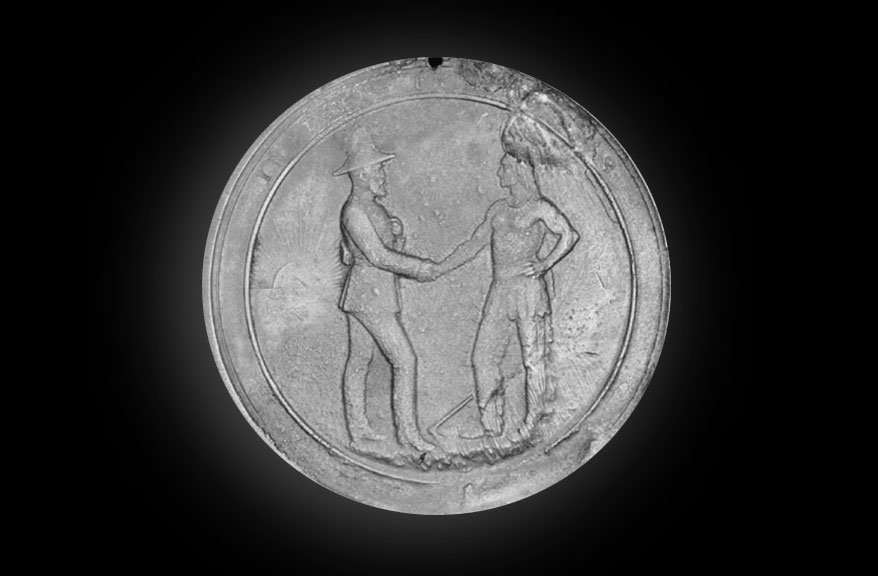Timeline
1750-1800
1787-1817
NWC and HBC Establish Posts in the Rainy Lake Region: Around 1787, the NWC establishes Fort Lac La Pluie (also known as Athabasca House or Rainy Lake House) to shorten turnaround time for Athabasca brigades. The HBC establishes posts nearby at Lac La Pluie, Escabitchewan House, Manitou Rapids, Rainy Lake, and Portage de l'Isle.
1800-1850
1822-1900
LLP District: Following the merge of the NWC and the HBC in 1821, the Lac La Pluie District is created, with its headquarters at Fort Frances. Between 1822 and 1900, the headquarters moved between Fort Frances, Rat Portage (now Kenora), and Fort Alexander.
1871
Halfbreeds of Fort Frances on Dawson Trail Paylist: "Halfbreeds of Fort Frances" are compensated when the construction of the Dawson Trail runs through their lands.
1878
Rainy Lake Métis Leader Nicholas Chatelaine Applies for Script: Nicholas Chatelaine applies for scrip in St. Vital, Manitoba. On his application, Chatelaine notes he had received "promisses [sic] from the officers of the government that I was to get my scrip at Fort Francis with many other people of that locality.” While many ancestors of the Northwestern Ontario Métis Community applied for scrip, many were denied because of their residence in Ontario, and confusion over the border between Ontario, the Northwest Territories, and Manitoba, which was not formally confirmed by the Crown until 1884.
2008
Signing of Consultation Protocol: After the Powley decision, Metis communities signed historic protocol agreements outlining the Crown’s duty to consult with Metis. The Consultation Protocol for Treaty #3, Lake of the Woods/Lac Seul and Rainy Lake/Rainy River Traditional Territories was signed in Fort Frances on November 3, 2008, by MNO President Gary Lipinski, Regional Councilor Theresa Stenlund, and Council Presidents Alvina Cimon (Northwest), Clint Calder (Sunset Country), and Joel Henley (Kenora). The protocol was renewed in 2011 and included the newly-created Atikokan Métis Council.
mid-1800s
Distinct Métis Community Present in What is Now Northwestern Ontario: In the early 1800s, NWC and HBC fur trade posts are home to growing Métis families. By the mid to late 1800s, a distinct Métis community is present in what is now Northwestern Ontario. Women and children also contribute to life at the posts, helping with daily labour as well as hunting, harvesting, and planting small gardens.
1850-1900
1873
Métis Act as Interpreters at the Signing of Treaty 3: In 1873, when the Canadian government signed Treaty 3 with chiefs representing the Saulteaux Nation, Métis were called on to fill the language gap between Saulteaux and government treaty-makers. Among the interpreters were Nicholas Chatelaine, George McPherson Sr., Duncan Begg and Catherine Spence. Despite serving as interpreters, the Metis were left out of Treaty 3 when it was signed in 1873. In exchange for surrendering their land, the Saulteaux would receive provisions, payments, and reserve land. The Metis would receive nothing.
1885
Petition of “Half-Breeds of Rainy Lake: The "Half-breeds of Rainy Lake" petition for the annuities promised in the Treaty 3 Adhesion.
1900-1950
1902
Métis in Present-Day Northern Ontario Recognized as Having Entitlement to Scrip Like Those in the West: In 1902, Indian Commissioner J.A. MCKenna acknowledged it was unjust that Métis claims in what is now Ontario could not be addressed through scrip, writing that “Halfbreeds living on the Keewatin side of the English River are recognized as having territorial rights and get scrip, scrip which they may locate in Manitoba or any part of the North West Territories, while the Halfbreeds on the Ontario side who naturally comes and makes claim has to be told that he has no territorial rights. We must take care to avoid the perpetuation of this.”
1950-2000
1982
Section 35 Recognizes Métis Rights: Section 35 of the Canada’s Constitution Act, passed in 1982, recognizes and affirms existing Aboriginal and treaty rights of Indian, Inuit, and Métis peoples of Canada. Though not initially included in early drafts, section 35 is added after Indigenous activists and organizations push to have their title and rights explicitly recognized by Canada. While section 35 constitutionally protects the Aboriginal rights of Métis in Canada, these rights have been further clarified through a series of subsequent Supreme Court decisions.
2011
Atikokan Métis Council is Formed: In 2011, the Atikokan Métis Council was formed, becoming the fourth community council representing members of the NWOMC.
1875
Métis of Rainy Lake Sign Half-Breed Adhesion to Treaty No. 3: Two years after the Canadian government signs Treaty 3 with First Nations, the Métis of Rainy Lake (present-day Fort Frances) under the leadership of Nicholas Chatelaine sign the “Half-Breed Adhesion to Treaty No. 3.” This marks the only time in Canada’s treaty history that the Métis are dealt with as a collective.
1891
Michel Morriseau’s Hungry Hall Land Claim Recognized: Canadian officials recognize Michel Morriseau's claim to 160 acres of land at Hungry Hall, stating in a letter that Morriseau is "not an Indian but has a right to land." Michel had applied for scrip only a few years earlier, in 1886, but like many Northwestern Ontario Métis his claim was denied due to residence in Ontario. In 1918, Michel's land was deeded to his children Sophia, James, Mary, Joseph, and John. Members of the Morriseau family continue to live on the land to the present day.
1994-1995
NWOMC Community Councils are Formed: In 1994 and 1995, the Sunset Country Métis Council, the Northwest Métis Council and the Kenora Métis Council were formed by Métis in Northwestern Ontario to protect the rights and traditions and promote the well being of members of the community.
2000-Present Day
2017
The Regional Councilor for Northwestern Ontario and Presidents of the Atikokan, Kenora, Northwest and Sunset Country Metis Councils and Canada (representing the MNO) sign the "Agreement on Advancing Reconciliation with the Northwestern Ontario Metis Community"















